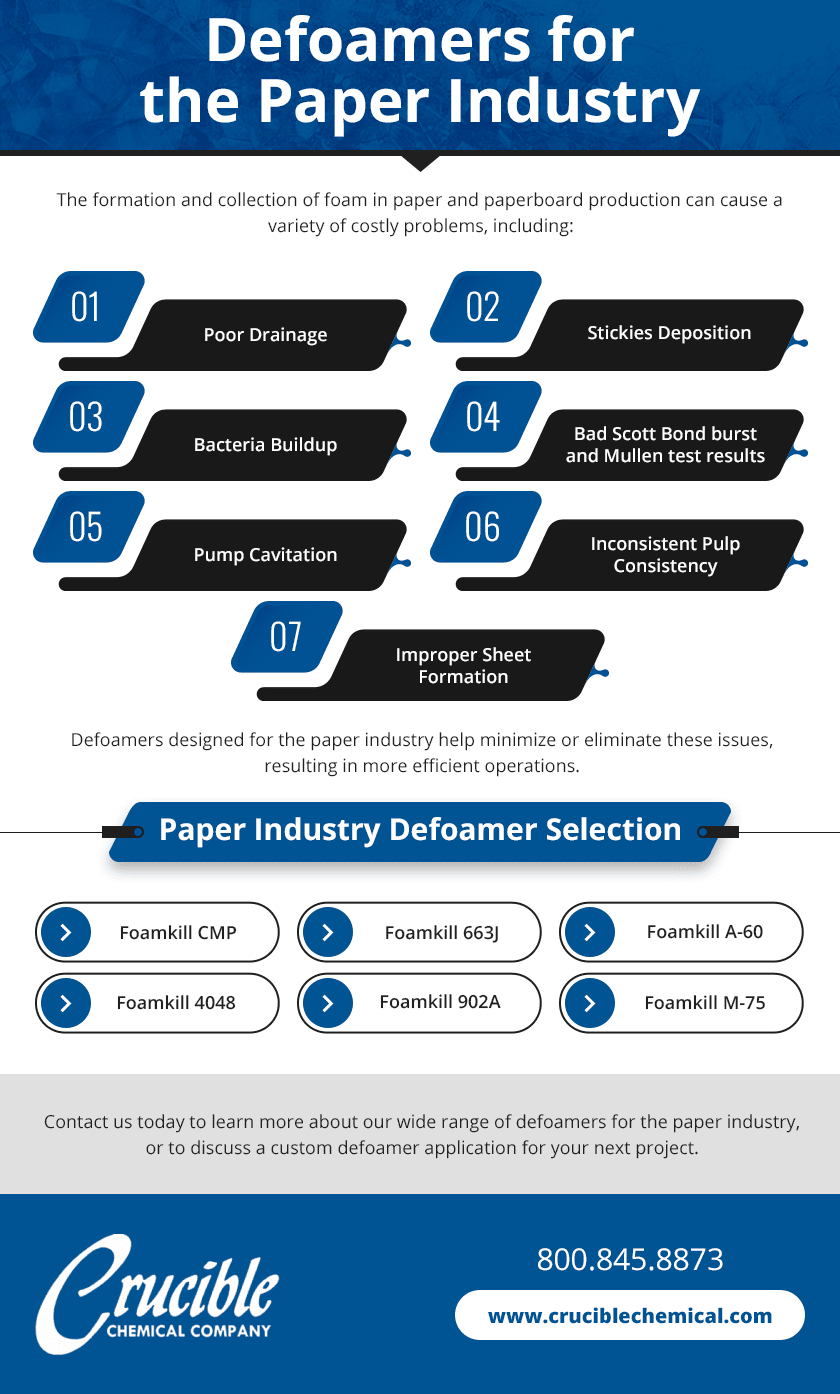Defoamers: Key Solutions for Managing Foam in Various Processes
Defoamers: Key Solutions for Managing Foam in Various Processes
Blog Article
Choosing the Right Defoamer for Your Details Application Requirements
Selecting the appropriate defoamer for details application requirements is a nuanced procedure that requires careful factor to consider of numerous variables, such as the foam tool, kind, and operating problems. Understanding the nuances of defoamer efficiency-- including rate and perseverance-- while also accounting for governing and ecological factors is crucial.
Understanding Foam Development
Foam development takes place when gas is trapped within a fluid, producing a stable structure of bubbles. This sensation can significantly influence numerous industrial processes, particularly in fields such as food production, drugs, and wastewater therapy. The visibility of foam can impede blending, lower item quality, and even bring about functional ineffectiveness.
Foam generally creates due to a mix of variables, including surface-active agents, frustration, and the attributes of the liquid phase. Surfactants lower the surface area tension of the fluid, facilitating the development of bubbles that can integrate and support. Agitation, whether from mechanical stirring or gas introduction, boosts bubble formation, resulting in raised foam quantity.
Recognizing the auto mechanics of foam formation is vital for markets intending to optimize their procedures. By identifying the certain conditions that promote foam generation, companies can execute techniques to alleviate its effects. This knowledge lays the groundwork for picking ideal defoaming representatives that properly target the unique obstacles positioned by foam in different applications. A detailed understanding of foam development is crucial for boosting efficiency and preserving item integrity throughout various markets.
Types of Defoamers Available
Different kinds of defoamers are available to deal with the difficulties presented by foam in industrial applications. defoamers. Generally classified, defoamers come under 3 groups: silicone-based, non-silicone-based, and natural defoamers
Silicone-based defoamers are renowned for their performance and stability across a wide variety of temperatures and pH levels. They are usually utilized in applications where strong foam reductions is needed, such as in finishes, adhesives, and paints. Their low surface tension enables fast foam collapse.
Non-silicone-based defoamers, frequently made from natural substances, offer an alternative for applications conscious silicone residues. These defoamers can be additional split right into polyether and ester kinds, each customized to meet particular formula demands. Non-silicone defoamers are often used in food handling and personal care items because of their compatibility with various formulations.
Natural defoamers, stemmed from plant or pet resources, are gaining traction due to their environmentally friendly profile. These items are particularly appealing in applications where regulative conformity and sustainability are vital, such as in agrochemicals and biotechnology.
Selecting the best type of defoamer is critical for maximizing performance and guaranteeing compatibility with specific applications.
Trick Application Factors To Consider
When picking a defoamer, it is vital to consider the certain application requirements to ensure optimum efficiency. defoamers. Different industries have distinctive needs, such as food handling, drugs, or wastewater treatment, and each application might require distinct defoaming properties
Trick elements to assess consist of the medium in which the defoamer will be used, whether it is water-based, oil-based, or a combination thereof. The temperature and pH degrees of the application can also significantly affect the performance of a defoamer. In addition, compatibility with other chemicals existing in the system is critical to avoid unfavorable responses that might endanger performance.
An additional crucial factor to consider is the lathering habits of the certain system. Understanding whether the foam forms promptly or gradually can direct the option of a defoamer that targets the source successfully. The preferred speed of defoaming can affect the selection, as some applications require rapid action while others might endure slower defoaming processes.
Lastly, regulative and ecological factors to consider ought to not be neglected, especially in markets with stringent conformity requirements. Choosing a defoamer that aligns with these aspects makes sure both effectiveness and security in the application.

Efficiency Testing Approaches
Evaluating the efficiency of a defoamer requires a systematic strategy to testing that properly measures its performance in details applications. Various performance screening approaches can be utilized to identify the optimal defoamer for an offered formula.
One common method is the bubble examination, which examines the defoamer's capacity to minimize foam quantity over time. This examination entails creating a stable foam my explanation and then including the defoamer to observe the rate of foam collapse.

Inevitably, picking the ideal performance screening method depends on the particular application and the type of foam being addressed. Each technique offers valuable information that can guide formula changes and improve the effectiveness of the defoamer in useful applications.
Ideal Practices for Choice


Following, consider the defoamer's performance in terms of rate of action and persistence. A quick-acting defoamer may be required for processes where quick foam suppression is critical, while an extra relentless solution could be required for extended foam control. In addition, examine the environmental effect of the defoamer, including its biodegradability and any governing conformity needs.
Conduct trials with chosen defoamers to establish their effectiveness in real-world conditions. By adhering to these best methods, you can improve foam control effectiveness and make certain the long life of your procedures.
Verdict
In recap, selecting the suitable defoamer necessitates a detailed analysis of numerous factors, including foam kind, tool, operating conditions, and environmental considerations. Understanding the distinct qualities of foam formation and the available defoamer alternatives is crucial. Additionally, employing effective efficiency screening techniques and sticking to ideal practices throughout the choice procedure will certainly enhance the chance of accomplishing optimum defoaming results. Eventually, an educated selection technique will certainly resolve specific application needs and alleviate frothing obstacles effectively.
Picking this hyperlink the ideal defoamer for specific application requirements is a nuanced process that demands careful consideration of multiple factors, such as the foam medium, operating, and type problems.Picking the right defoamer is important for achieving optimum efficiency in foam next page control applications. A quick-acting defoamer may be required for processes where rapid foam reductions is essential, while an extra consistent formula might be required for long term foam control.In summary, selecting the appropriate defoamer demands a thorough analysis of different elements, consisting of foam kind, medium, operating problems, and ecological considerations. Understanding the distinct features of foam development and the readily available defoamer choices is critical.
Report this page